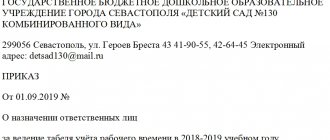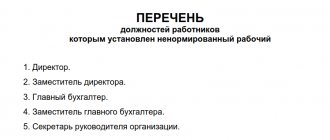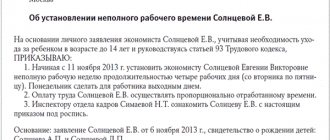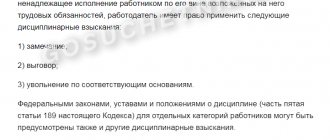Legal regulation
Each organization establishes special rules that regulate:
- time of arrival/departure of employees;
- production security;
- rules of ethics;
- hiring procedure;
- dismissal procedure;
- rules on bonuses and penalties.
These norms constitute the internal regulations of the work collective, which must be followed by both employees and employers. According to Art. 21 of the Labor Code of the Russian Federation, when entering work, employees must comply with:
- rules of labor discipline established at the enterprise;
- internal organizational order;
- labor safety and health standards.
In order to ensure that the employee complies with all production regulations, it is necessary to document all the rules of the labor process. In accordance with Art. 189 of the Labor Code of the Russian Federation, such obligations must be formalized in the form of:
- local regulations;
- provisions;
- charter.
The development of a local act on the rules of employee conduct is carried out by the personnel service. The regulations/charter on labor discipline are approved by the management of the enterprise and stipulate:
- general obligations of the employee and employer;
- types of incentive measures that management can apply to an employee;
- a detailed description of disciplinary penalties for employee misconduct.
Since such a local act does not always contain detailed information about the rules for recording specific employee misconduct, the employer needs to issue clarifying orders.
How is the following working time regime established - part-time work week?
The regulation of a part-time work week in an organization is established through the execution of a number of internal documents of the enterprise.
Thus, when introducing a shortened regime, by agreement between the parties, the following is required:
- worker's statement;
- management order;
- additional agreement to the employment contract.
When introducing an incomplete week, by decision of management, the following are formalized:
- order for the enterprise on the work schedule;
- informing employees about changes in schedule;
- additional agreements to employment contracts (if necessary);
- Notifying the employment service about changes in working hours.
Functional
One of the documents that establishes specific obligations of employees is an order on compliance with labor discipline. With this order, the employer can:
- establish clear conditions for the secondment of management employees (for example, the presence of a call or invitation);
- determine what actions may be considered a misconduct (for example, going on a business trip without approval from the HR department);
- indicate the time frame within which management must be notified about the vacation schedule, etc.
How to write a work order on a holiday
The order on work on holidays, a sample of which can be found below, does not have a form approved by law. It is compiled in any form. The basis for publication is a memo to the head of the organization (about the need to go to work) and a document in which the employee expressed his consent to work outside of normal hours.
The administrative document is signed by the manager; the employee himself and the responsible persons (QA inspector, chief accountant, etc.) must familiarize themselves with it directly.
The order has the following structure:
- "A cap". Here indicate the document number and the date of its publication.
- Next, they state the basis for working on a holiday and a link to the Labor Code article.
- Main part. The text of the order indicates the full name. and the positions of employees who will have to work on a public holiday, working hours, an agreed upon compensation option, an instruction to the chief accountant to pay double for the work (if this particular compensation method was chosen). The name and details of the document that became the basis for issuing the order are also indicated here.
The order on the work schedule on holidays contains an order from the head of the organization regarding which days will be considered working days. The Labor Code of the Russian Federation requires the issuance of such an order without fail (Article 113 of the Labor Code of the Russian Federation).
An employer does not have the right to force hired personnel to work on holidays. If an employee does not want to go to work on his day off, he only needs to verbally notify his superiors about this; he does not need to sign anywhere. In this case, the employer does not have the right to impose disciplinary sanctions or threaten dismissal.
Contents of the document
The legislation of the Russian Federation does not establish the essential conditions of the order on compliance with labor discipline. Therefore, the employer draws up a form for such an order at his own discretion.
Based on the customs of personnel records management, the necessary elements of the document can be identified:
- full name (“Order on approval of labor discipline”, “Order on strengthening control over the time of arrival/departure of employees”);
- number, date and city of compilation;
- reasons for the issuance (for example, “Due to the increasing incidence of abuse by employees”, “In order to suppress cases of unauthorized absence from the workplace”, etc.);
- an indication of the measures being introduced (approval of a log of employee arrivals/departures, creation of commission checks of the department’s work, etc.);
- Full name, position of the person responsible for executing the order;
- Full name, position of the signatory.
In the form, as an appendix to the order, you can draw up samples of applications, registration sheets, journals and other documents that will strengthen compliance with labor discipline. The order is signed by the head of the organization. If his deputies or the head of the personnel department have the authority to put signatures in personnel documents, the order can be endorsed by such employees.
Order on pre-holiday shortened working day - details
In order to correctly document the reduction of the pre-holiday working day in personnel records, the order must contain a number of mandatory details. There is no single standard form, but the document must include information about the enterprise, indicate the basis for reducing the duration of employment, and also reflect data on the employees who are entitled to this benefit and the number of hours of reduction.
Additionally, the date and number of the order, full name of the director, and a list of structural divisions of the company are provided. When filling out, you must follow the internal document flow regulations. Persons covered by the order are required to familiarize themselves with its contents with a personal signature. The order is first approved by the head of the enterprise. To make it clear exactly how a sample order for a shortened pre-holiday day is drawn up, study the example.
Errors
One of the most common is the mistake in understanding the essence of the order to comply with labor discipline. Often, under this order, incentives are given for the employee’s compliance with established labor rules. However, this document has nothing to do with bonuses.
With various types of incentives, the employer draws up an order to issue any gift or value to the employee (the reason may also be compliance with the discipline established in the organization). In this case, it is advisable to call the document not “Order on compliance with labor discipline”, but “Order on bonuses”, and indicate compliance with labor regulations as the basis.
An order on the observance of labor discipline cannot infringe on the rights of workers. For example, it is illegal to impose restrictions on weekends or make vacations subject to any conditions. The order can only correct:
In other cases, you can complain about the employer’s order to the Labor Inspectorate or court.
Order to change the work schedule: features of the document structure
An order to adjust employee work schedules must include:
1. Basic details - name, publication date, number.
2. Text block with justification for changing the work schedule, as well as a link to Art. 74 of the Labor Code of the Russian Federation, on the basis of the provisions of which the order is issued.
The justification may be, for example, the modernization of the production technology of goods, as a result of which the number of work shifts at the enterprise changes.
3. A text block with operative wording (“I order”) and a list of local norms introduced through an order.
4. A text block that records management’s orders to individual employees regarding ensuring the legality of the implementation of the provisions of the order.
In particular, in Art. 74 of the Labor Code of the Russian Federation states that the employer must offer other positions to employees whose work schedule changes.
5. A text block establishing the date and procedure for the order to come into force.
The document is signed by the head of the company. It is also necessary to familiarize employees with its provisions. Based on the order, new labor regulations (or additional agreements to employment contracts) are subsequently drawn up, which fix the changed work schedule.
If there is a change in the work schedule at the initiative of the employee, then the basis for issuing a similar order will be the statement of the initiator himself, that is, the employee.
Sep 10, 2019adminlawsexp
voice
Article rating
Shelf life
Personnel documentation of the enterprise is subject to mandatory storage during the entire period of work. According to the Order of the Ministry of Culture of the Russian Federation dated August 25, 2010, documents on the procedure for granting vacations, duty, business trips, as well as on rewards and punishments for employees, must be in the organization for 75 years.
The order, which introduces adjustments to labor discipline, contains additional information about the rights and responsibilities of employees. It is the legal basis for bonuses or dismissals, therefore, it relates to personnel documents and must be preserved for 75 years. If the company closes before the specified deadline, all personnel records are transferred to state archives.
The time during which an employee, in accordance with the internal labor regulations and the terms of the employment contract, must perform labor duties is working time (Part 1 of Article 91 of the Labor Code of the Russian Federation).
The working time regime provides for the length of the working week, work with irregular working hours, the duration of daily work (shift), start and end times of work, time of breaks in work, number of shifts per day, etc. (Part 1 of Article 100 of the Labor Code of the Russian Federation).
How to draw up an order about the working hours of employees?
What is labor discipline
Labor discipline is the rules and norms of behavior of employees taken in their entirety while they perform their work functions at the enterprise as part of the workforce. This concept (labor discipline) is considered one of the essential institutions of labor law in general.
Labor discipline has several aspects. First of all, this is a fundamental principle of labor law. In other words, this is the key provision of this section of the law. The principle of labor discipline assumes that personnel must comply with the requirements imposed by the standards of conduct.
As an institution of labor law, it can be considered as a whole set of legal norms that regulate the routine within the organization. These standards regulate the labor responsibilities that employees have, as well as the responsibilities of the employer in relation to its employees. They also include methods for ensuring labor discipline, including rewards for positive results achieved by employees in the performance of their functions, as well as measures of responsibility for failure to achieve proper results due to the fault of employees.
In particular, for violation of discipline, liability is provided, which is logically called disciplinary. Such liability differs from its more stringent types (administrative or civil, not to mention criminal) in that the sanction for the violator of discipline (penalty) is not imposed by the state (represented by the court).
This step is taken by the enterprise itself in the person of the manager (general director), who, by his decision, applies a penalty, in the form of which can be a reprimand, reprimand or dismissal (but not a fine, although deboning is permissible, but does not apply to disciplinary sanctions, since the issuance awards are at the discretion of the company). An alternative option is the imposition of such a penalty by the labor discipline commission, which will be discussed in the corresponding section below.
Such norms are generally contained in Section VIII of the Labor Code of the Russian Federation. In a separate organization, specific provisions are also established by a local legal act, which is usually the internal labor regulations. This document is usually developed by the company's lawyers and approved by order of the manager (general director).
Internal labor regulations must, in their content, comply with all provisions of both the Labor Code and any other laws. In particular, they should not worsen the employee’s position in comparison with the law.
In addition, in certain socially important sectors or in those where neglect of discipline can lead to catastrophic consequences, their own regulations on discipline or charters apply. In particular, they are adopted for all existing types of transport, in the communications industry, and the fishing industry.
In addition, labor discipline is also understood as the actual situation at a given enterprise with employees complying with the requirements of discipline in the previous understanding. In this aspect, we can talk about high discipline, when, in general, employees strictly comply with the standards established for them, and about average, when such provisions are observed satisfactorily, but not without deviations. Finally, discipline can be low when such norms are not respected. In the latter case, care must be taken to strengthen control over performance discipline.
Order on keeping a working time log
The magazine is designed for slightly different purposes. It is needed to ensure constant control over the attendance of registered workers at their workplaces. This local document will reflect both departure and arrival hours. If a person commits absenteeism, then measures arising from the rules of labor discipline of the enterprise and a specific unit can be applied to him on the basis of data from this local regulatory act.
A system for such fixation of working hours is being introduced after an order is issued by the general director of the company. In addition to the very fact of the existence of the new rule, it will indicate who is responsible for maintaining this document.
In practice there are three cases:
- the manager himself (in very small enterprises);
- head of a specific department;
- employee from the HR department.
Most employers lean towards the latter option. Another difference between companies when it comes to logging relates to how often it is completed. There is daily, weekly and cumulative accounting.
Order on keeping a log of employees' working hours - sample
By writing an order, a journal and time sheet are not only created, but changes are made to them in the same way. A sample of such an order can be found below.
Summarized labor time recording
The procedure for introducing summarized recording of working time is established by Art. 104 of the Labor Code of the Russian Federation in cases where none of the other methods can be used (for example, with round-the-clock, shift work or a rotating schedule).
The basis for its use is the right to add up hours worked at different times to comply with the production norm, but over a longer period. The main condition for the summation of work is the fulfillment of labor standards based on the results of counting hours.
This form is often used with a sliding work schedule. Local acts of the organization establish a period within which the working hours of employees are controlled, which, despite the different time frames of employment, in total will give an average forty-hour norm.
Summarized working time recording: calculation examples
Employee salary: 20,000 rubles.
To determine the hourly rate, it is necessary to multiply the salary by the number of months in a year and divide by the number of working hours in a year: 20,000 × 12 / 1973 = 121.64 rubles (hourly rate).
Salary determination will be calculated based on the number of hours worked multiplied by the hourly rate.
Rules for keeping a work schedule log
The rules depend on what schedule each employee works. In any case, a certain period is selected for which the results are summarized. It is believed that the maximum period for control during summary accounting is one year, and in hazardous working conditions - three months.
How to create a work schedule journal?
For registration today, either a manual or printed version can be used. Manual remains more traditional - in it, each employee confirms the entries made with a personal signature. Such magazines are sold in almost all printing houses. Also, for this option, you can simply print out standard sheets with a lined table and sew them together.
The electronic version involves the use of special software. Thanks to the software, you can automatically generate reports at any time for the period of interest to the manager. Modern software allows you to implement time control using special electronic passes and cards that are issued to employees.
Time log - sample
The first page in this type of documentation is the title page. In addition to the name itself, this sheet indicates when the journal began and when it ended.
The main part of the document is presented in table form. The first column in this table is date. Next comes the time of arrival at the workplace, after which the full name of the employee is indicated. After this, the time of his departure is recorded and in the next field it is calculated how many total hours he spent at the workplace. The same employee signs opposite the entries about himself.
A separate column is reserved for notes that can be entered by the person responsible for filling out this form.
IT solutions for working time control
Supervising the work of a small team manually is a feasible task for the immediate manager or one dedicated specialist. But if the company’s staff numbers more than one hundred people, who also work in branches or remotely, only automation can cope with such a task.
In addition, monitoring the work of personnel is needed not only to record the performance of an individual employee, but also to ensure the safety of the enterprise. IT solutions perform two tasks simultaneously to monitor productivity during working hours. Automated systems record information, conduct analysis and generate reports.
The cost of implementing an automatic working time monitoring program is covered by minimizing the employer’s costs associated with the absence of personnel from the workplace: absenteeism, tardiness, long breaks. IT tools record and analyze data, on the basis of which management encourages the “leaders” of the office, thereby motivating the entire team to work more productively and disciplinedly.
Automated IT systems allow you to identify:
- violators of discipline - employees who are systematically late or go home earlier than expected, heavy smokers or coffee drinkers whose “five-minute” breaks exceed the duration of work.
- workers who, during working hours, decide on personal matters, read news and social network feeds, conduct friendly rather than official correspondence in instant messengers, and play on the computer.
- employees who are so overloaded with work tasks and are forced to constantly stay late at work, which threatens professional burnout and, in extreme cases, a nervous breakdown.
- employees who are not satisfied with their position on certain issues and are busy looking for a new job.
The capabilities of SearchInform CIB are even wider. In the ProfileCenter module, you can analyze the psychological characteristics of employees and create risk groups that require special control.
Automated monitoring of working hours is not limited to the installation of specialized software and also includes the installation of control equipment at the entrance/exit of the building; equipment of checkpoints; use of a personal identifier system for each employee; recording the movement of personnel while working on the territory of the enterprise using GPS beacons.
An integrated approach to monitoring working time involves analyzing the work of specialists according to control points: staffing, work plan, deadlines for completing tasks, territory for performing duties, production schedule.
How to choose an IT solution for working time control
When choosing software for monitoring working time and assessing staff performance, it is worth considering the specialization of the solution and immediately answer the question for what purpose the program is being installed: only to collect data or to analyze staff performance.
Next, you need to decide whether a program that provides quantitative reports on the arrival and departure of an employee is sufficient for the purposes of implementation, or whether a solution is required that will record exactly what the employee did during working hours. A useful option is the ability to take screenshots according to a predefined schedule or when certain processes are launched.
Managers are interested in the effectiveness of not only an individual employee, but also the entire team. Most often, top management is not interested in information about exactly what games the employee was distracted by or with whom exactly he corresponded, but in the total amount of time wasted. Therefore, an additional advantage of the program is the ability to generate not only detailed, but also summary reports.
Assess opportunities
"
CIB SearchInform
"
is available during a 30-day trial. For a free test, a program with full functionality is provided. Submit a request for a test.








